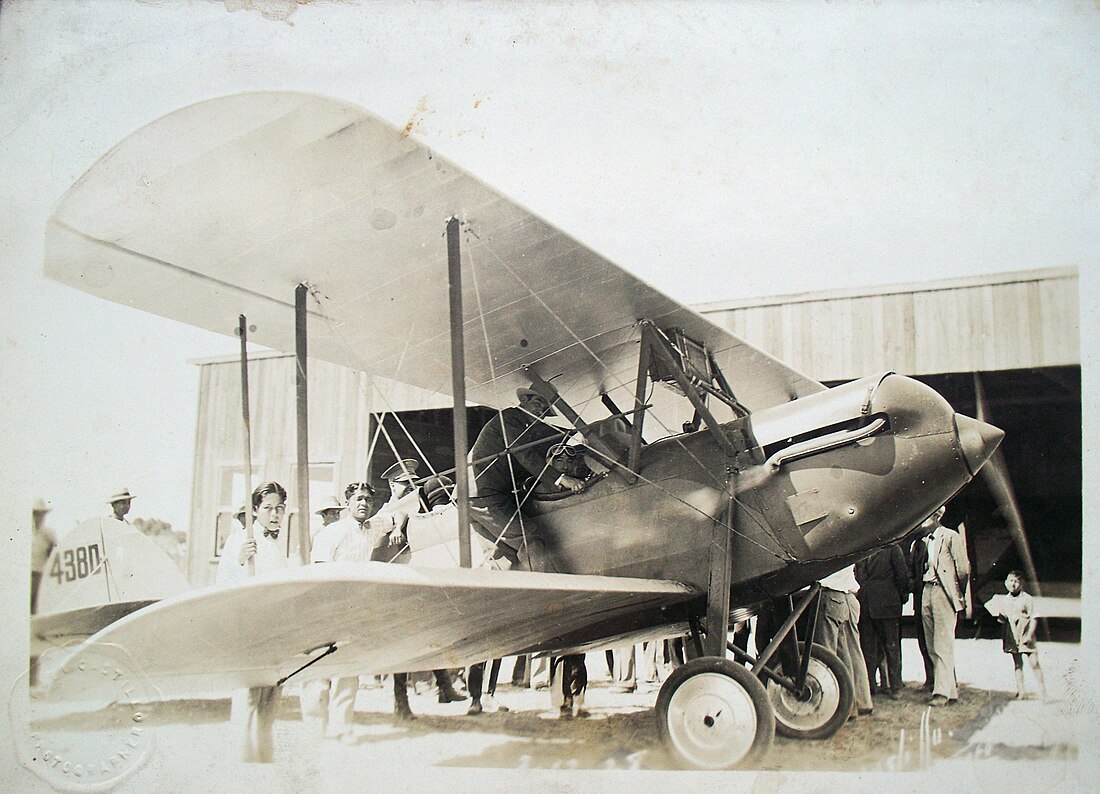Top Qs
Timeline
Chat
Perspective
Waco 10
American biplane From Wikipedia, the free encyclopedia
Remove ads
The Waco 10/GXE/Waco O series is a range of three-seat open-cockpit biplanes built by the Advance Aircraft Company, later the Waco Aircraft Company.

Remove ads
Design and development
The Waco 10 was a larger span development of the Waco 9, both single-engined three-seat single-bay biplanes constructed around steel-tube frames. The wing covering was fabric, and both upper and lower planes carried ailerons, which were strut linked. The two passengers sat side by side in a cockpit under the upper wing and ahead of the pilot, who had a separate cockpit. It had a split-axle fixed undercarriage and a tailwheel. The main undercarriage was fitted with hydraulic shock absorbers, unusual at the time on a light aircraft. The fin could be trimmed on the ground to offset engine torque, and the tailplane could be trimmed in flight. Initially it was powered by a Curtiss OX-5 water-cooled 90° V-8 engine producing 90 hp (67 kW).
Its first flight was in 1927. It was numerically the most important type to be built by Waco, with at least 1,623 built over a period of 7 years from 1927 to 1933 and was fitted with a very large variety of engines of radial and V configuration.
Remove ads
Operational history
The Waco 10 turned out to have excellent handling, and there was a ready supply of war-surplus Curtiss engines. It was widely used for the popularisation of aeronautics through barnstorming and joyrides, and was also much used as a trainer and by small operators for charter flights.
Variants
Summarize
Perspective
In 1928, after the Waco 10 had entered production, Waco changed its designation system so that the basic model 10, powered by a 90 hp (67 kW) Curtiss OX-5 engine became the GXE.



Later aircraft used three-letter designations, the first denoting the engine (except for the two mailplanes), the second denoting the wing installed, S or T meaning Straight or Tapered wing, and the final O indicating it was a derivative of the 10. An -A suffix indicated an armed variant intended for export.
Apart from the water-cooled V-8 Curtiss and Hispano-Suiza engines, all of the rest were air-cooled radials.
Other engines were fitted experimentally, without unique designations, including the Rausie, Ryan-Siemens, and 115 hp (86 kW) Milwaukee Tank engine. This last engine was an air-cooled version of the Curtiss OX-5, and was intended as an aircraft engine.
The JYM and JWM were mailplane derivatives with a 14" fuselage stretch.
In the 1990s the unrelated The WACO Aircraft Company in Forks, Washington offered a homebuilt kit version of the ATO model.[1]
The WACO 240-A was a straight-wing fighter, built for export, powered by 240 hp (180 kW) Wright engine. At least six were bought by the Cantonese Chinese aviation services. They were armed with twin .30 Browning machine guns and had racks for five 25 lb (11 kg) or two 100 lb (45 kg) bombs.[2]
There was also an export model WACO Pursuit 300T-A, with 300 hp (220 kW) Wright or Wasp Jr engine.[2]
Military designations
- D1W
- Brazilian Navy designation for the CSO.[3]
Remove ads
Surviving aircraft
Remove ads
Specifications (Waco GXE)
Data from Aerofiles[23]
General characteristics
- Crew: 1
- Capacity: 2 passengers
- Length: 23 ft 6 in (7.16 m)
- Wingspan: 30 ft 7 in (9.32 m)
- Height: 9 ft 0 in (2.74 m)
- Airfoil: Aeromarine 2A[24]
- Empty weight: 1,199 lb (544 kg)
- Gross weight: 2,025 lb (919 kg)
- Powerplant: 1 × Curtiss OX-5 V-8 water-cooled piston engine, 90 hp (67 kW)
- Propellers: 2-bladed fixed-pitch propeller
Performance
- Maximum speed: 97 mph (156 km/h, 84 kn)
- Cruise speed: 84 mph (135 km/h, 73 kn)
- Stall speed: 37 mph (60 km/h, 32 kn)
- Range: 380 mi (610 km, 330 nmi)
- Rate of climb: 500 ft/min (2.5 m/s)
Remove ads
See also
Aircraft of comparable role, configuration and era
(Partial listing, only covers most numerous types)
Related lists
References
Further reading
Wikiwand - on
Seamless Wikipedia browsing. On steroids.
Remove ads

